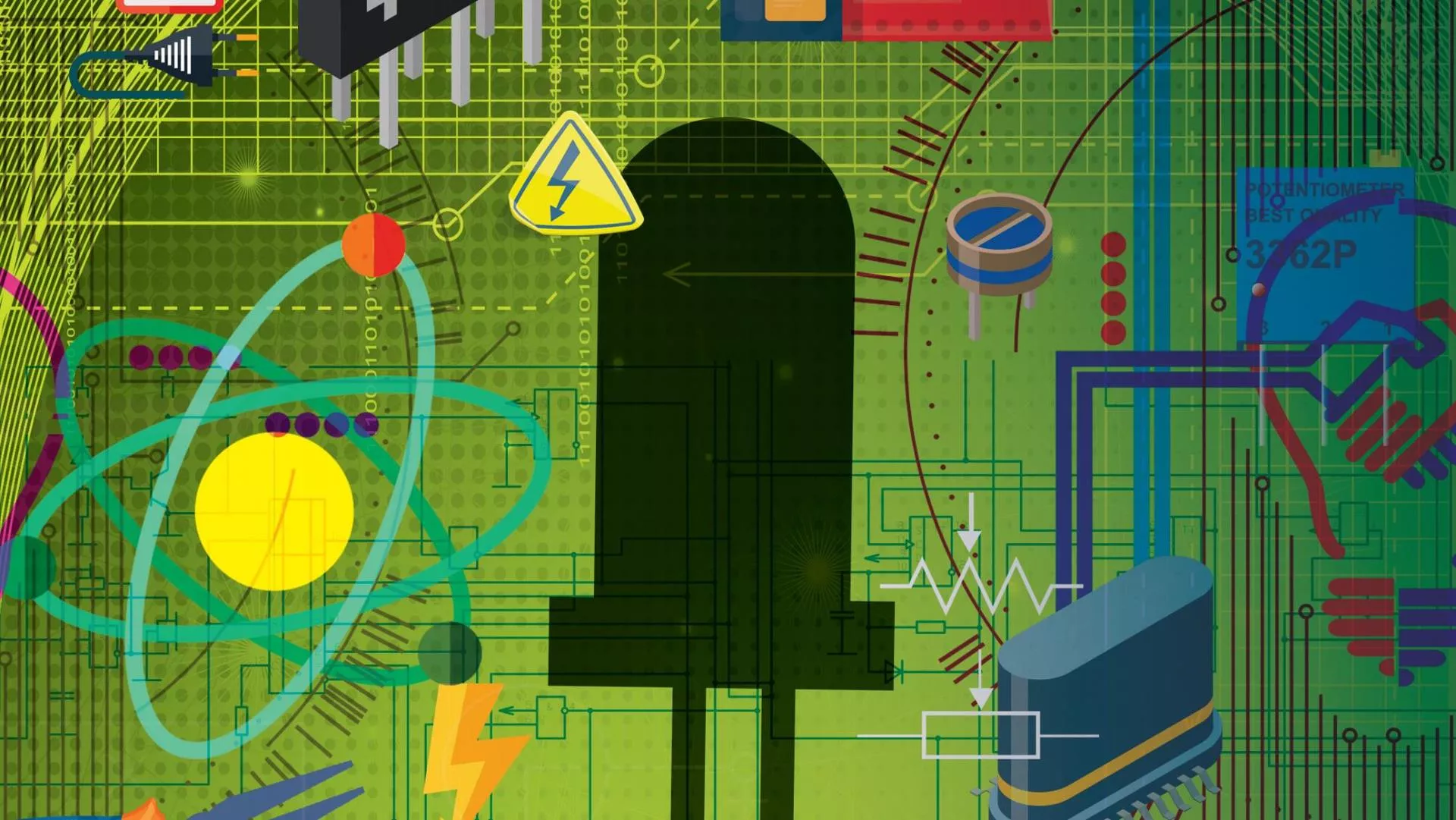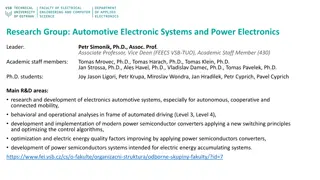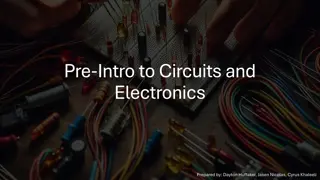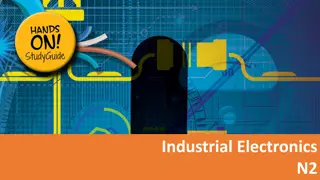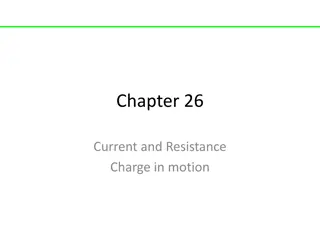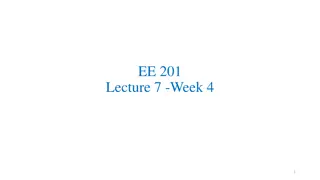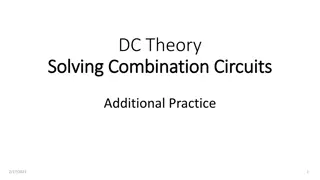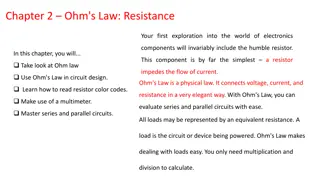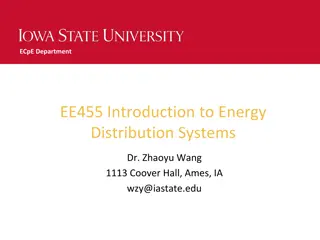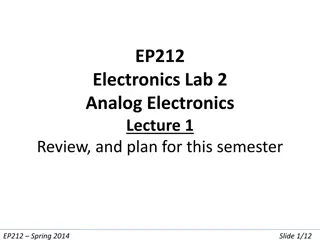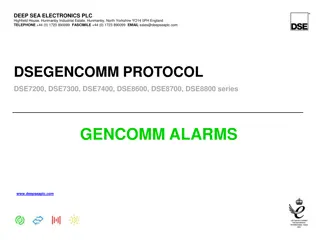Understanding Kirchhoff's Current Law in Industrial Electronics
Kirchhoff's Current Law in industrial electronics states that the total current flowing into a point is equal to the total current flowing out of that point. This fundamental principle is essential for analyzing and designing electrical circuits, ensuring the conservation of current flow at any junction.
Download Presentation

Please find below an Image/Link to download the presentation.
The content on the website is provided AS IS for your information and personal use only. It may not be sold, licensed, or shared on other websites without obtaining consent from the author. Download presentation by click this link. If you encounter any issues during the download, it is possible that the publisher has removed the file from their server.
E N D
Presentation Transcript
Chapter 1 Kirchhoff's Law KIRCHHOFF S LAWS Kirchhoff s Current Law states that the algebraic sum of currents entering a point will be equal to the algebraic sum of the currents leaving that point. Kirchhoff s Voltage Law states that the algebraic sum of the individual voltage drops in a closed network is equal to the algebraic sum of the applied voltage. www.futuremanagers.com
Chapter 1 Kirchhoff's Law (continued) APPLICATION OF KIRCHHOFF S LAWS In setting up two equations you must understand that theory will form the basis. Furthermore, the concepts of Ohm s Law are equally applicable since Kirchhoff s Laws has as origin Ohm s Law. www.futuremanagers.com
Chapter 2 Superposition Theorem INTRODUCTION The Superposition Theorem states that all current magnitudes and directions may be determined by considering each supply on its own. www.futuremanagers.com
Chapter 2 Superposition Theorem (continued) CURRENT- AND VOLTAGE DIVISION The current will divide between the two resistors and will always take the path of least resistance. The voltage will divide between the two resistors and the largest resistor will also have the largest voltage drop. www.futuremanagers.com
Chapter 3 Thevenins Theorem INTRODUCTION Thevenin s Theorem specifies that a complex network consisting of impedances and voltage sources may be replaced by a constant voltage source with a series impedance. www.futuremanagers.com
Chapter 3 Thevenins Theorem (continued) APPLICATION OF THEVENIN S THEOREM It is however important that you must have a thorough background of Ohm s Law since Thevenin s Theorem has that law as basis. www.futuremanagers.com
Chapter 4 Series RLC-networks THE EFFECT OF AN ALTERNATING QUANTITY ON A RESISTOR Below we see: A resistor connected across an alternating current supply (a); A graphical representation of the phase relationship between the current and the supply voltage (b); and A phasor diagram (c). www.futuremanagers.com
Chapter 4 Series RLC-networks (continued) THE EFFECT OF AN ALTERNATING QUANTITY ON AN INDUCTOR Below we see: An inductor connected across an alternating current supply (a); A graphical representation of the phase relationship between the current and the supply voltage (b); and A phasor diagram (c). www.futuremanagers.com
Chapter 4 Series RLC-networks (continued) THE EFFECT OF AN ALTERNATING QUANTITY ON A CAPACITOR Below we see: A capacitor connected across an alternating current supply (a); A graphical representation of the phase relationship between the current and the supply voltage (b); and A phasor diagram (c). www.futuremanagers.com
Chapter 4 Series RLC-networks (continued) THE SERIES R-L NETWORK This is a network consisting of an inductor and resistor connected in series. www.futuremanagers.com
Chapter 4 Series RLC-networks (continued) THE SERIES R-C NETWORK This is a network consisting of a capacitor and resistor connected in series. www.futuremanagers.com
Chapter 4 Series RLC-networks (continued) THE SERIES RLC-NETWORK This is a network consisting of a resistor, capacitor and inductor connected in series. www.futuremanagers.com
Chapter 4 Series RLC-networks (continued) CONDITIONS FOR RESONANCE The following conditions will exist for ? = ? and is minimum resonance in a series RLC-network. ? = 0 ??= ?? ??= ?? and is maximum ??= ?? I is maximum 1 ? = 1 2 2 ? ? ? www.futuremanagers.com
Chapter 5 Parallel RLC-networks THE PARALLEL RL-NETWORK This is a network consisting of an inductor and resistor connected in parallel. www.futuremanagers.com
Chapter 5 Parallel RLC-networks (continued) THE PARALLEL RC-NETWORK This is a network consisting of a capacitor and resistor connected in parallel. www.futuremanagers.com
Chapter 5 Parallel RLC-networks (continued) THE PARALLEL RLC-NETWORK This is a network consisting a resistor, capacitor and inductor connected in parallel. www.futuremanagers.com
Chapter 5 Parallel RLC-networks (continued) CONDITIONS FOR RESONANCE The following conditions will exist for resonance in a parallel RLC-network. ? is minimum ??= ?? ??= ?? and is maximum ??= ?? ? = 0 I is minimum 1 ? = 1 2 2 ? ? ? www.futuremanagers.com
Chapter 5 Parallel RLC-networks (continued) THE TUNED NETWORK A more practical parallel network is illustrated below and is termed a tuned network or a tank circuit . www.futuremanagers.com
Chapter 6 Q-factor, Bandwidth and Complex Notation THE Q-FACTOR The Q-factor of a network is also termed the magnification factor and is applicable to either a series- or parallel resonant network. This factor is mathematically expressed by: ? =?? ? www.futuremanagers.com
Chapter 6 Q-factor, Bandwidth and Complex Notation (continued) BANDWIDTH The bandwidth may be defined as that range of frequencies between ?1 and ?2 where the power has fallen or dropped to half its value. www.futuremanagers.com
Chapter 6 Q-factor, Bandwidth and Complex Notation (continued) COMPLEX NOTATION Complex notation is a method used to calculate different quantities in alternating current networks in modulus and angle form which gives us a much easier method of calculation. www.futuremanagers.com
Chapter 7 Basic Atomic Theory THE STRUCTURE OF MATTER Matter may be defined as anything that has mass and that occupies space and can be composed of elementary substances that are found in nature. Matter can be divided into the following groups: Solids; Liquids; Gasses; and Plasma. www.futuremanagers.com
Chapter 7 Basic Atomic Theory (continued) ATOMS An atom may be defined as the smallest part of an element that can participate in a normal chemical reaction. All atoms consist of minute particles of electrical charges arranged in a set pattern and consist of: Electrons; Protons; and Neutrons. www.futuremanagers.com
Chapter 7 Basic Atomic Theory (continued) ENERGY SHELLS In the diagram, the centre circle represents the nucleus consisting of the protons and neutrons and the outer circle or circles indicates the shells for the orbiting electrons. www.futuremanagers.com
Chapter 7 Basic Atomic Theory (continued) VALENCY The number of electrons in the outer shell of an atom, called the valence shell, will determine the valency of that element. Valency is an indication of the ability of an atom to gain or lose electrons and will determine the electrical properties of that element. www.futuremanagers.com
Chapter 7 Basic Atomic Theory (continued) CONDUCTION Movement of electrons or conduction can and will take place in any given conducting material, in a desired direction, should a source of power be applied across such material. The conduction process can be by either hole flow (transfer) or electron motion or by both. www.futuremanagers.com
Chapter 7 Basic Atomic Theory (continued) ENERGY BANDS In any given material, conducting or insulating, there are two distinct energy bands in which electrons may exist, namely the conduction band and the valence band but they will be separated by the forbidden gap. www.futuremanagers.com
Chapter 8 PN-Junction Theory INTRODUCTION There are two main elements that are used in the manufacture of semi- conductor devices or components namely Silicon and Germanium. As the name Semi-conductor suggests, it is not a very good conductor and something needs to be done in order to improve on its conducting capabilities. www.futuremanagers.com
Chapter 8 PN-Junction Theory (continued) CRYSTAL LATTICE STRUCTURES In the diagram, the circles represent the nucleus of the atom and the squares indicate the valence electrons in the valence shell. This type of crystal lattice structure is found in all crystalline elements. www.futuremanagers.com
Chapter 8 PN-Junction Theory (continued) DONOR DOPING Donor doping is a mixing process that will generate a free (extra) electron in the conduction band of the atom as well as crystal lattice structure. www.futuremanagers.com
Chapter 8 PN-Junction Theory (continued) ACCEPTOR DOPING Acceptor doping is a mixing process that will generate a hole in the conduction band of the atom as well as crystal lattice structure. www.futuremanagers.com
Chapter 8 PN-Junction Theory (continued) FERMI-LEVELS The Fermi-level may be defined as the amount of energy the free electrons as well as the holes possess within the material. www.futuremanagers.com
Chapter 8 PN-Junction Theory (continued) THE PN-JUNCTION A PN-junction is formed when a P-type material and an N-type material is joined together. This joining together is not an electrical junction but is a junction which is achieved through a manufacturing process in which electrons and holes are uniformly distributed in the two types of material provided they have been doped to the same extent. www.futuremanagers.com
Chapter 9 Semi-conductor Diodes INTRODUCTION A diode may be defined a single PN-junction two terminal device which will offer a low resistance when forward biased and a high resistance when reverse biased. www.futuremanagers.com
Chapter 9 Semi-conductor Diodes (continued) THE DIODE AND CHARACTERISTIC CURVE The characteristic curve is depicted below: www.futuremanagers.com
Chapter 9 Semi-conductor Diodes (continued) BASIC RATING FACTORS OF A DIODE Rating factors will assist during the design phase of circuits so that reliable as well as satisfactory operation can be assured. They can be seen as: Low current - Up to 49 ampere; Medium current - 50 ampere to 199 ampere; and High current - 200 ampere and higher. www.futuremanagers.com
Chapter 9 Semi-conductor Diodes (continued) ELECTRICAL CHARACTERISTICS OF A DIODE The electrical characteristics of a diode are based on the absolute maximum rating system and provide information pertaining to the maximum values that may not be exceeded for a given diode. These specifications are always contained in the manufacturers specification sheets. www.futuremanagers.com
Chapter 9 Semi-conductor Diodes (continued) THE DIODE EQUATION ? = ??(???/??)-1 Where i = forward current ??= reverse saturation current q = electron charge V = potential difference across the diode K = Boltzmann s constant T = temperature www.futuremanagers.com
Chapter 9 Semi-conductor Diodes (continued) FORWARD RESISTANCE OF A DIODE All diodes are manufactured from semi-conductor materials and will have a resistance caused by its atomic structure. This resistance is given by: ? =? ? ? ? Where K = Boltzmann s constant T = temperature in Kelvin q = electron charge www.futuremanagers.com
Chapter 9 Semi-conductor Diodes (continued) THE DIODE LOAD-LINE The load-line for a diode is obtained by considering the maximum values of forward current and the maximum value of the forward bias for a particular rectifier diode. www.futuremanagers.com
Chapter 10 Diode Applications APPLICATION OF DIODES Diodes have applications such as: Clippers; and Rectifiers. www.futuremanagers.com
Chapter 10 Diode Applications (continued) RECTIFIER CONCEPTS There are a number of concepts that will determine the magnitude of the output obtained from a rectifier. These are: The transformer ratio; Average dc-voltage; Ripple voltage; Ripple factor; and PIV-rating. www.futuremanagers.com
Chapter 10 Diode Applications (continued) FILTER NETWORKS A filter can be defined as a component that will remove the ripple (pulsating) component from the output of a rectifier circuit. www.futuremanagers.com
Chapter 10 Diode Applications (continued) NO-LOAD VOLTAGE The no-load voltage of any power supply may be defined as that voltage which is supplied by the secondary winding of the transformer when the load to that power supply is not connected. www.futuremanagers.com
Chapter 10 Diode Applications (continued) VOLTAGE REGULATION Voltage regulation may be defined as that change in the output voltage (full- load) for varying load conditions. www.futuremanagers.com
Chapter 10 Diode Applications (continued) VOLTAGE MANIPULATION At times, greater voltages are required and for this purpose we make use of voltage multiplication circuits which may, depending on the design, supply two or more times the peak input value as an output. www.futuremanagers.com
Chapter 11 Special Diodes and Applications THE ZENER DIODE The zener diode is constructed so that it is mainly used in the reverse bias mode. When operated in the forward bias mode, however, its forward characteristics are similar to that of an ordinary junction diode. www.futuremanagers.com
Chapter 11 Special Diodes and Applications (continued) THE VARACTOR DIODE The varactor diodes are semi-conductor, voltage-dependent, variable capacitors. Their mode of operation is determined by the capacitance that exists at the PN-junction when the device is reversed biased. www.futuremanagers.com
Chapter 11 Special Diodes and Applications (continued) THE TUNNEL DIODE The tunnel diode is also termed an Esaki diode. It is also a two-terminal device and is almost exclusively used as a high-frequency component in the following applications: An amplifier; An oscillator; and A switch. www.futuremanagers.com


